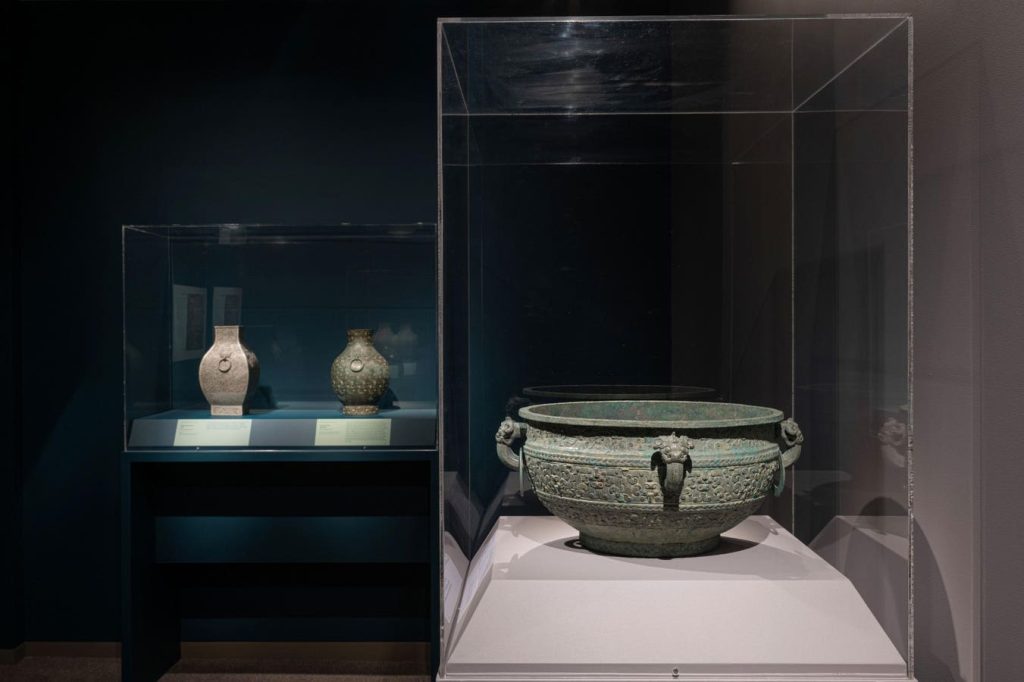The China Institute Gallery in New York is showing one of the world’s greatest collections of ancient Chinese bronzes outside of China from a crucial period in the history of human civilization, 12th century BCE to 1st to 2nd century CE.
The China Institute Gallery in New York is displaying ancient ritual bronzes owned by the Minneapolis Institute of Art through July 13
China Institute Gallery
Lent by the Minneapolis Institute of Art, the Bronze Age vessels for food and wine and imaginative animal sculptures are on view for the first time in New York through July 13.
According to the China Institute Gallery, “The emergence of the culture of bronze—an alloy of copper, tin and lead—remains a crucial chapter in the history of human civilization. Although China was not the first country to enter the Bronze Age, its bronzes from this period are unique in world history because of their variety and intricacy, the ritual context in which they developed and the sheer number that have been unearthed over China’s vast territory. The people of Bronze Age China believed in the hierarchy of beings, from the heavens to the king to the royal courts to the people. They created their art to maintain this order on earth and in the afterlife.”
The gallery explained that “in ancient China, ancestor worship, a practice based on the belief in life after death and the connection between the deceased and the living, played a significant role in daily life. Communal good depended on showing respect to ancestral spirits. This practice led to the establishment of ancestral temples to accommodate such rituals. Bronze vessels were made and then used to offer food and wine to the dead in elaborate ceremonial banquets. Their mystical surface decorations, particularly animal images, served as a means to communicate with spirits and deities. Ritual bronze vessels also gave the living an opportunity to acknowledge their debt to their ancestors, as well as the deeds and virtues of the deceased. In this way, ritual bronze vessels enhanced the sacredness and power of a temple.”
It added that “ritual bronzes were also used as funereal objects, buried in the tombs of nobles to provide the deceased with the same material environment they enjoyed in life, thus assuring immortality.”
Large sets of bronze bells were also important elements in the ritual ceremonies that allowed the living to connect with the dead. The gallery said this “is evidenced by the inscriptions on many musical instruments excavated in the past several decades from sites dating to the Western Zhou dynasty (1046–771 BCE). An inscription on a bronze bell dating to the early 900s BCE reads, ‘I made this set of harmonically tuned chime bells. Use it so as to please and exalt those who arrive in splendor and to let the accomplished men of former generations rejoice.’”
In addition, the gallery said “there were profound political implications in linking ancestral rites and music. During the Western Zhou dynasty, the Zhou maintained a strict hierarchy based on a patriarchal clan system. An individual’s duties, power and term of service were defined by his social status. Without musical harmony, society itself would become discordant. Therefore, music was emphasized as a means to help the populace follow the moral and social order and to regulate their conduct.”
During the Eastern Zhou dynasty (771–256 BCE), the gallery also said there were “important changes in the function, shape, decoration and style of bronzes. Due to advances in casting technology, changes in social conditions and evolutions in regional taste, new fashions in ritual bronze casting arose. During the Shang and Western Zhou dynasties, bronze vessels were primarily used for sacrifices to ancestors. During the Eastern Zhou, however, bronze vessels diverged from the realm of religious ritual and began to be seen as luxury items in their own right, used by their owners to show off their wealth and power. Bronzes became more ornate in appearance, with extensive use of three-dimensional pendants.”
The gallery called the Han dynasty (206 BCE–220 CE) “the epilogue of the Chinese Bronze Age. During this period, the concept of immortality—the physical departure from human society and the achievement of eternal life—became a national preoccupation. This idea, influenced by Daoist teachings on eternity, had a tremendous impact on daily life and extended to representations in works of art, including bronzes.”
The image of a goddess known as Queen Mother of the West. the most popular deity during this period, decorates bronze mirrors, while bronze horses like the one in the exhibition were placed in elaborately furnished aristocratic tombs to provide transportation for the deceased in the afterlife.

